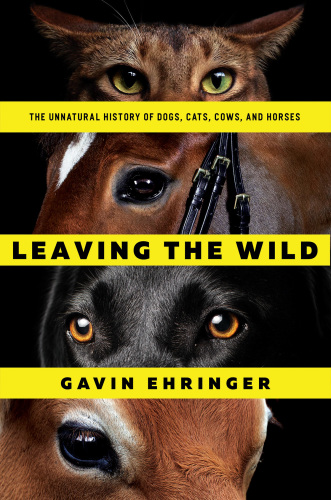
Leaving the Wild
The Unnatural History of Dogs, Cats, Cows, and Horses
- اطلاعات
- نقد و بررسی
- دیدگاه کاربران
نقد و بررسی

October 15, 2017
Colorado-based writer Ehringer (100 Best Ranch Vacations in North America, 2007, etc.) chronicles our changing relations--changes mostly not for the better--with the world of familiar animals. The author's travels among everyday animal species and their histories opens a touch sluggishly, with a story that has become commonplace: namely, the domestication of the dog out of the wolf, the latter a smart predator that found a new way of exploiting its environment by moving, with humans, into the newfangled villages of newfound agriculturalism. From there, however, the narrative picks up both speed and interest. Ehringer writes capably, for example, of the development of dog species, hinting at some political resistance in the mix as "royal kennel keepers smuggled puppies out of the castles to sell to commoners rather than give the inferior ones the blade or bludgeon." Inferior, perhaps; who knows how much better the queen of England's corgis are than your next-door neighbor's? One such species is the mixed-bag creation called the pit bull, more properly the bull & terrier, "less a breed than a type of dog," in this case bred to nefarious purposes for fighting--and that for human entertainment. Ehringer reports that, thanks to good education, the numbers of unwanted dogs in pounds and shelters are declining relative to the past; the challenge for future dog owners will be to find animals that have been humanely bred. Not necessarily so the cat population, cats being critters that evolved, writes the author, quite against their types, since cats in the wild "profoundly dislike and distrust people." Ehringer moves from cats to cows, writing that, though it's not their fault, there are too many cows to be sustainable. In the future, they're likely to be scarcer; indeed, after considering the fortunes of horses, he imagines a time "when grandparents fondly recall the days when animal food products were common." Solid, well-reported popular science for animal lovers.
COPYRIGHT(2017) Kirkus Reviews, ALL RIGHTS RESERVED.

November 1, 2017
A longtime chronicler of the American West for magazines such as Western Horseman, Ehringer explores how dogs, cats, cows, and horses have fared under domestication and human association. He relates how this group of domesticates has adapted well to human "care, understanding, and love" but also documents examples of neglect and cruelty: homeless pets, dog fighting, the deleterious effects of inbreeding in dogs and horses, and inhumane factory farm conditions for cattle. Ehringer is a facile writer, but his approach to this topic is uneven. The section on dogs is considerably longer than that for any other domesticate. We learn much about Australian Shepherds because the author has been involved with this breed for decades, but his experience with cats is limited to semiwild barn cats. He discusses when, where, and how the domestication process began for cats, dogs, and horses yet provides no information about the domestication of cattle from the extinct aurochs. VERDICT Given these inconsistencies and the lack of cited sources, this title is recommended for those interested in a casual read. For a more thorough look at animal domestication, turn to Richard C. Francis's Domesticated.--Cynthia Lee Knight, Hunterdon Cty. Historical Soc., Flemington, NJ
Copyright 2017 Library Journal, LLC Used with permission.




دیدگاه کاربران